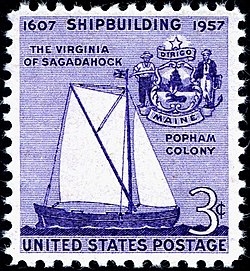Virginia of Sagadahoc
Virginia or Virginia of Sagadahoc was a pinnace built in 1607–08 by colonists at the Popham Colony. The ship was a project of the Plymouth Company, branch of the proprietary Virginia Company, on land England claimed as belonging to the Virginia Colony. She was the first English-built ship in what is now Maine and possibly in all of the English-colonized areas of North America, and a demonstration of the new colony's ability to build ships. The second and third "local" pinnaces (Deliverance and Patience) were built soon afterwards in Bermuda following the loss of Sea Venture during the Third Supply.
Virginia was built at the mouth of the Kennebec River in what is now Phippsburg, Maine. Little is known about the details of her architecture, but written accounts of the colony and historical records of similar ships suggest that Virginia was a pinnace that displaced about 30 tons and measured somewhat less than 50 ft (15 m) long, with a beam of 14 ft 6 in (4.42 m). She had a flush main deck, drew about 6 ft 6 in (1.98 m) fully loaded, and had a freeboard of less than 2 ft (0.61 m).
The Popham Colony, also known as the Sagadahoc Colony, was established in 1607 by the Plymouth Company. It was situated near the present town of Phippsburg, Maine near the mouth of the Sagadahoc River, now the Kennebec River. The expedition's mission was to find gold, the Northwest Passage, a river passage to China, to fish and hunt Beaver for fur and to sell and prove that New World forests could build English ships.
...
Wikipedia

